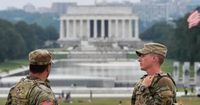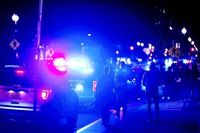In the heart of the nation’s capital, a fierce debate is unfolding over the true state of public safety and the integrity of the numbers meant to measure it. Since President Donald Trump declared a public crime emergency on August 11, 2025, and took the extraordinary step of federalizing Washington, D.C.’s police department, the city has seen a dramatic shift—not only in its law enforcement approach but also in the national spotlight now cast on its crime statistics.
According to the DC Police Union and data reported in Thursday’s AM Update, the president’s crackdown has coincided with a notable drop in crime. Overall crime is down 8 percent, with robberies plummeting by 46 percent, assaults with a deadly weapon down 6 percent, carjackings down a staggering 83 percent, car thefts down 21 percent, violent crime down 22 percent, and property crime down 6 percent. These numbers, if taken at face value, would signal a remarkable turnaround in a city that saw a spike in violent crime in 2023—the worst in nearly two decades as the COVID-19 pandemic waned.
But as the city’s leadership and federal overseers tout these achievements, a cloud of suspicion has settled over the data itself. On August 20, 2025, the Department of Justice confirmed that it had launched a federal investigation, led by U.S. Attorney Jeanine Pirro, into allegations that the Metropolitan Police Department (MPD) manipulated crime statistics to make the city appear safer than it really is. This high-profile probe follows months of internal scrutiny and mounting pressure from both the Trump administration and the D.C. Police Union.
Police Commander Michael Pulliam, a central figure in the controversy, was placed on paid administrative leave in May amid an internal investigation into accusations that he changed crime data to downplay the severity of incidents in the city’s 3rd District. Pulliam has denied all wrongdoing, but the allegations have not gone away. D.C. Police Union Chairman Gregg Pemberton has been vocal about what he describes as a longstanding practice within the department. Speaking to Fox News, Pemberton alleged, “One of the chief complaints among our members is that they would respond to the scenes of these violent crimes only to have a captain, or a commander, or sometimes a lieutenant show up on the scene and advise them to take a report for a lesser offense.” He gave examples: burglaries reported as unlawful entry, thefts, or, in some cases, shootings and stabbings going entirely unreported if the victim was uncooperative. “They will be directed to take an ‘injured person to the hospital report,’ which is not even a crime at all, it’s an incident report,” Pemberton explained, adding that this manipulation has been “part and parcel of the police department for some time.”
Mayor Muriel Bowser, for her part, has defended the city’s numbers, crediting a “precipitous” two-year decline in crime to hard work, legislative changes, and a reimagined public safety ecosystem. “We know that crime has gone down in our city, and it has gone down precipitously over the last two years because of a lot of hard work, changes to our public safety ecosystem, including changes to the law, and we know those facts don’t comport to what some people are saying,” Bowser told News4 on August 20, 2025.
Chief of Police Pamela Smith echoed the mayor’s confidence but acknowledged the seriousness of the federal investigation. “I have not been contacted but I am aware that there, there may be or will be subpoenas issued,” Smith said. She confirmed that the investigation into Commander Pulliam is ongoing and remains open to federal scrutiny. Smith also described her relationship with Terry Cole, the federal official appointed by the Trump administration to oversee the department, as “very, very congenial” and “collaborative.”
The tension between federal and local authorities has only grown in recent weeks. After President Trump’s emergency declaration and the deployment of hundreds of National Guard troops and federal agents, the city’s daily life changed overnight. Union Station, once a symbol of decline and disorder, became the backdrop for a show of force—and, on August 20, a photo-op as Vice President J.D. Vance, Defense Secretary Pete Hegseth, and Deputy Chief of Staff Stephen Miller served lunch to law enforcement officers stationed there. “We don’t have to live like this. We do not have to allow our cities to be taken over by violence and by disorder and by chaos,” Vance declared. “You just got to have the political willpower to do it.”
Yet, even as the administration claims victory, critics on the left have called the federal intervention an unnecessary power grab. They point to independent data from the Council on Criminal Justice, which shows that crime is down in more than three dozen cities nationwide since 2023. In fact, homicide rates have fallen more sharply elsewhere than in D.C. itself. City officials argue that the president’s rationale for seizing control is undermined by the broader, nationwide trend.
Still, the investigation presses on. U.S. Attorney Jeanine Pirro’s office is now examining whether false statements or fraud played a role in producing D.C.’s crime data. As reported by The San Juan Daily Star, the probe is another salvo in the ongoing feud between federal and local authorities—one that has already led to lawsuits and a tentative truce over police authority and immigration enforcement. The Justice Department has demanded that local officers aid more in federal immigration efforts, a demand that city leaders have only partially conceded.
Meanwhile, the D.C. Police Union continues its own review, having questioned more than 100 police reports for possible misclassification. Pemberton told NBC News, “There’s a, potentially, a drop from where we were in 2023. I think that there’s a possibility that crime has come down. But the department is reporting that in 2024, crime went down 35%—violent crime—and another 25% through August of this year. That is preposterous to suggest that cumulatively we’ve seen 60-plus percent drops in violent crime from where we were in ’23, because we’re out on the street. We know the calls we’re responding to.”
As the investigation unfolds, the city’s leadership is urging patience and transparency. Mayor Bowser met with police officers on August 19 to hear their concerns and reaffirm the city’s commitment to public safety. U.S. Attorney General Pam Bondi noted on social media that 550 arrests have been made since the emergency declaration, though she acknowledged that it remains unclear how many of those were for crimes versus immigration violations.
For now, D.C. residents are left to parse dueling narratives: one of a city on the mend, restored by federal intervention and new resolve, and another of a capital still struggling with the accuracy of its own reflection. Whether the numbers tell the whole truth—or merely a convenient version of it—remains to be seen as federal prosecutors dig deeper and the city’s future hangs in the balance.

